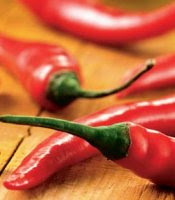Indonesian Chili Peppers
Capsicum Annum
Cabe (Chili Peppers) or Cabe (pronounced chaw-bay) plays such a dynamic and central role in Indonesian cuisine that it's hard to imagine things before the Portuguese brought it there 500 years ago. The molecule capsaican is responsible for all the excitement. Its stimulates temperature-sensitive nerves on the tongue and elsewhere producing the false sensation of heat. This irritation of pain receptors is a sensation that some of us have learned to enjoyed!
The heat of a particular chili can vary considerably, so until you get a feel for a particular type it is better to err on the mild side of things. The seeds are the hotest part and also the hardest on the stomach. Most of Indonesians don't bother removing them, but you shouldn't feel like a woose for slicing the chili in half and scraping out the seeds. You might also substitute red or green bell peppers.
Cabe Hijau and Cabe Merah
Pile after sizzling pile of these garden and red chili peppers dominate entire sections of Indonesian farmer's markets. They are long and curly as opposed to the short and squat varieties encountered in the West.
Cabe Rawit
Tiny but hot, these chilies are often directly nibbled on for contrast with fried tofu and even certain sweets. Sometimes called bird eye peppers or nok noy in Thai.
There's another kind of Indonesian Chili Peppers, Indonesian called it Cabe Rawit (cayenne pepper), it is common inmost Asian markets, but the other Indonesian varieties can be difficult to find in the West. Luckily you can replace them with common anaheim, jalapeno, or serrano varieties. Generally speaking, chilies get hotter as they get smaller, so maintaining the recipe's chili count while substituting different sized varieties will usually result in an equal degree of hotness. One notable exception is perhaps the World's hottest chili: the habanero.
Sambal Ulek
This is red chili that has been crushed and bottled with a little salt as preservative. It keeps well and provides an easy way to add chili toany dish. Use about 1/2 table spoon of sambal ulek for each chili pepper called for. Also use it as a shortcut for making relishes like sambal balado.
Working with Cabe
The hot oilfrom chilies can burn your fingers so be careful not to touch your face, eyes, and other "sensitive" body parts.
Bookmark/share this article with others:Cabe (Chili Peppers) or Cabe (pronounced chaw-bay) plays such a dynamic and central role in Indonesian cuisine that it's hard to imagine things before the Portuguese brought it there 500 years ago. The molecule capsaican is responsible for all the excitement. Its stimulates temperature-sensitive nerves on the tongue and elsewhere producing the false sensation of heat. This irritation of pain receptors is a sensation that some of us have learned to enjoyed!
The heat of a particular chili can vary considerably, so until you get a feel for a particular type it is better to err on the mild side of things. The seeds are the hotest part and also the hardest on the stomach. Most of Indonesians don't bother removing them, but you shouldn't feel like a woose for slicing the chili in half and scraping out the seeds. You might also substitute red or green bell peppers.
Cabe Hijau and Cabe Merah
Pile after sizzling pile of these garden and red chili peppers dominate entire sections of Indonesian farmer's markets. They are long and curly as opposed to the short and squat varieties encountered in the West.
Cabe Rawit
Tiny but hot, these chilies are often directly nibbled on for contrast with fried tofu and even certain sweets. Sometimes called bird eye peppers or nok noy in Thai.
There's another kind of Indonesian Chili Peppers, Indonesian called it Cabe Rawit (cayenne pepper), it is common inmost Asian markets, but the other Indonesian varieties can be difficult to find in the West. Luckily you can replace them with common anaheim, jalapeno, or serrano varieties. Generally speaking, chilies get hotter as they get smaller, so maintaining the recipe's chili count while substituting different sized varieties will usually result in an equal degree of hotness. One notable exception is perhaps the World's hottest chili: the habanero.
Sambal Ulek
This is red chili that has been crushed and bottled with a little salt as preservative. It keeps well and provides an easy way to add chili toany dish. Use about 1/2 table spoon of sambal ulek for each chili pepper called for. Also use it as a shortcut for making relishes like sambal balado.
Working with Cabe
The hot oilfrom chilies can burn your fingers so be careful not to touch your face, eyes, and other "sensitive" body parts.


















0 comments:
Post a Comment